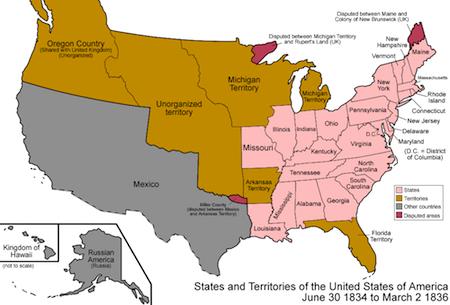23 Defining Moments in Immigration Policy History
A super easy guide to more than 200 years of immigration policy.
Nov. 27, 2012— -- Ever wondered how we ended up with this cobbled-together immigration system?
Drawing on a mix of sources, including Guarding the Golden Door, here are the 23 defining moments in immigration policy history that helped create the system we know today:
1. Naturalization Act of 1790
- It restricted naturalization to "free white persons." Naturalization restrictions by race were not completely removed until 1952.
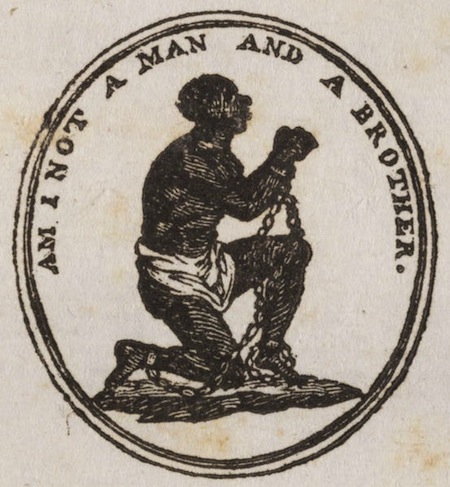
The "Am I Not a Man And a Brother" anti-slavery medallion produced by Josiah Wedgwood in 1787. (Wikimedia)
2. Alien and Sedition Acts (1798)
- These were less immigration laws and more of a political weapon used by Federalists against Jeffersonians. The short-lived acts never actually resulted in any deportations, but did cause imprisonments and force some immigrants to flee the country.
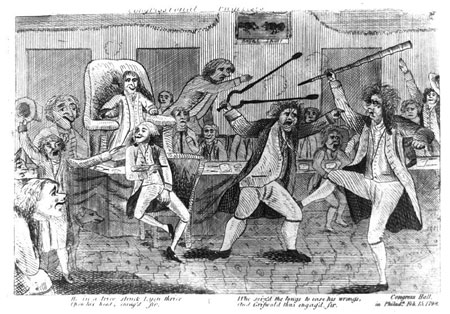
An illustration of a fight on the floor of Congress between Vermont Representative Matthew Lyon and Roger Griswold of Connecticut. Lyon was a Democratic-Republican and Griswold a Federalist. (Library of Congress)
3. Treaty of Guadalupe Hidalgo (1848)
- The treaty that gave the U.S. what would become states like Arizona, California and New Mexico also extended citizenship to Mexicans living in the newly annexed territory.
- Piles of stones were set up across the southern border to mark the division between the U.S. and Mexico.
Map of the states and territories of the United States as it was from 1834 to March 1836. (Golbez/Wikimedia Commons)
4. Rise of the Know Nothings (1850)
- The country's first politically impactful anti-immigration group fielded two presidential candidates, Daniel Webster (a famous statesman who died during his campaign) and Millard Fillmore (the former president). Both candidates lost in their presidential bids, but the Know Nothings controlled the Massachusetts legislature and won political seats across the country before a collapse in 1855.
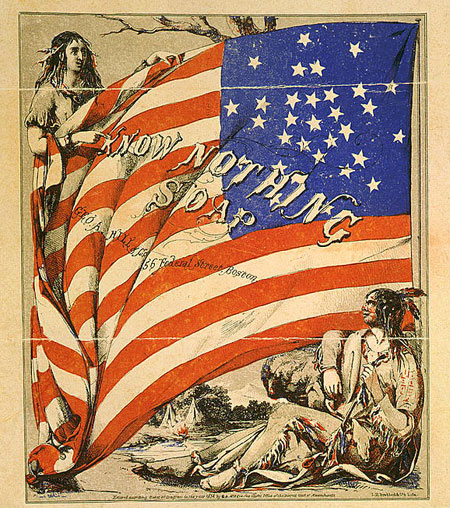
An illustrated advertising label for soap manufactured in Boston, interesting for its imagery and allusion to the popular "Know Nothing" or nativist movement. (Library of Congress)
5. Adoption of 14th Amendment (1868)
- The amendment stated that anyone born in the U.S. would automatically become a U.S. citizen.
- The Naturalization Act of 1790 that limited naturalization to "free white persons" was extended to people of African descent in 1870, but not to Asians.
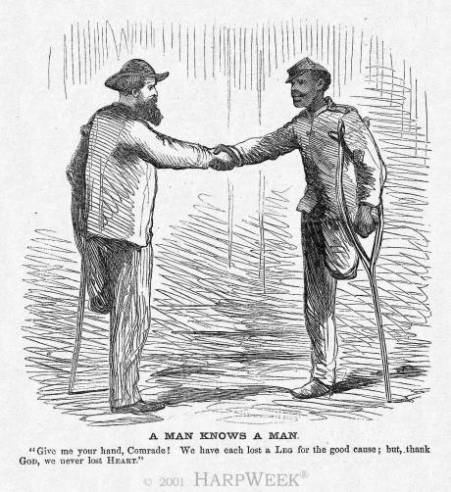
On April 22, 1865, Harper's Weekly featured a cartoon about black and white Civil War veterans. (HarpWeek)
6. Page Act (1875)
- This act prohibited immigrants considered undesirable from entering the U.S., but was effectively geared toward Chinese laborers and Chinese women who were deemed to be prostitutes.

An illustration stereotyping Chinese immigrants, published in The Wasp, a San Francisco magazine, 1877. (Library of Congress)
7. Chinese Exclusion Act (1882)
- Chinese labor was banned for a period initially outlined as 10 years, but the law and subsequent extensions, which eventually barred immigration from all Asian nations, were not repealed until 1943.
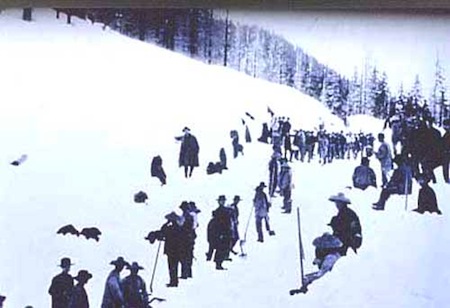
An undated photo of Chinese railroad workers for transcontinental railroad. (Wikimedia)
8. Immigration Act of 1882
- The first general immigration law added a 50 cent head tax to enter the U.S. as a ship passenger, and put the Secretary of the Treasury in charge of immigration.
- For the first time, immigration officials were told to deny entry to immigrants deemed "liable to become a public charge," a designation that by 1931 would be used to deny entry based on economic standing.
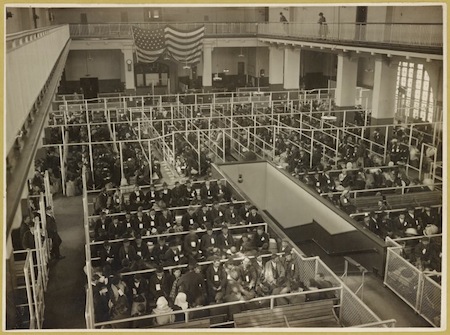
The pens at Ellis Island, main hall. These people have passed the first mental inspection, 1902-1913. (Edwin Levick/New York Public Library)
9. Immigration Act of 1891
- This act established the Office of the Superintendent of Immigration within the Treasury Department, the beginning of a national immigration service.

A private interview between a young immigrant and an Ellis Island official. What appear to be two staff members are also present, 1902-1910. (William Williams/New York Public Library)
10. Immigration Act of 1917
- The Act added more restrictions to who should be admitted. Among those excluded were "homosexuals," "feeble-minded persons" and "epileptics."
- It also created a literacy test for immigrants entering the U.S., where those over 16 years of age had to read a passage in a recognized language.
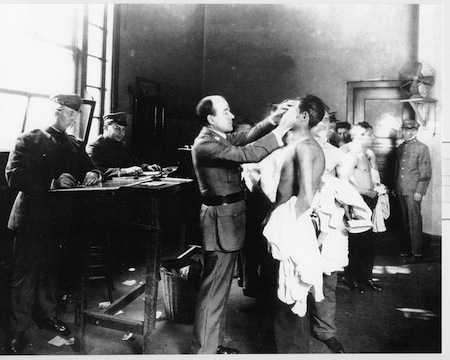
Health inspectors examine detainees on Angel Island, Calif. 1917. (National Archives)
11. Jones–Shafroth Act (1917)
- It granted U.S. citizenship to all citizens of Puerto Rico.
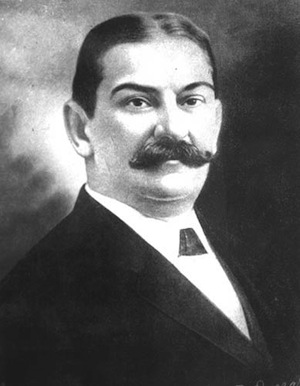
Luis Muñoz Rivera was a Puerto Rican poet, journalist and politician. He was a major figure in the struggle for political autonomy of Puerto Rico. (Library of Congress)
12. Immigration Act of 1924
- Restricted immigration overall, introducing a quota system to limit the number of immigrants coming from any single nation. Western and Northern European nations were favored.
- It was signed into law by President Calvin Coolidge, who, as vice president, wrote about Nordic supremacy in a Good Housekeeping essay: "Biological laws tell us that certain divergent people will not mix or blend. The Nordics propagate themselves successfully. With other races, the outcome shows deterioration on both sides."
- Immigration dropped from nearly 707,000 in 1924 to roughly 294,000 in 1925.
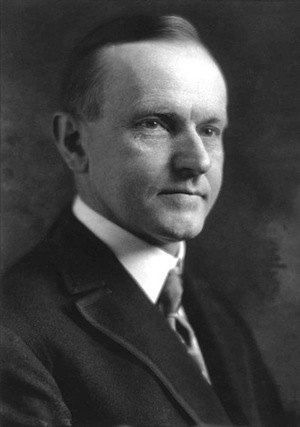
President Calvin Coolidge, 1923. (Wikimedia Commons)
13. Bracero Program (1942)
- The program brought more than 400,000 Mexican workers to the U.S. during peak years in the late 1950s. It ended in 1964 amid opposition from labor unions.
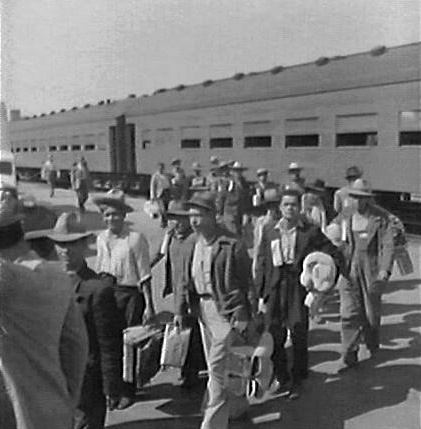
The first Braceros arrive in Los Angeles by train in 1942. (Wikimedia Commons)
14. Displaced Persons Act of 1948
- As the first major legislation geared toward refugees, the law allowed hundreds of thousands of displaced Europeans to resettle in the U.S. The law, passed well after the conflict had ended, temporarily suspended discriminatory quotas that had limited immigration from Eastern European counties, from which millions of Jews and other refugees had attempted to flee during the war.

American twin-engine bombers, shown being hoisted aboard ship in an unnamed American port, 1941. (U.S. National Archives/Flickr)
15. McCarran–Walter Act (1952)
- This act retained the quota system from the Immigration Act of 1924 and gave preference to certain countries, like Great Britain, Germany and Ireland, while reducing the number of immigrants from colonies in the New World.
- It allowed for deportation of immigrants involved in subversive activities.
- It banned racial and ethnic discrimination over who can naturalize, allowing Asians to naturalize.
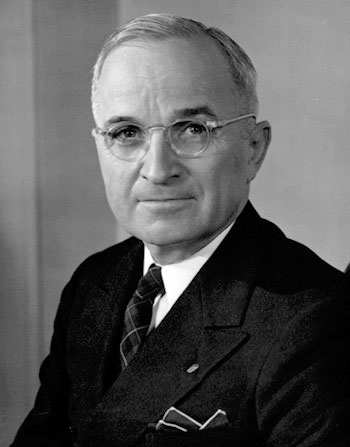
President Harry Truman vetoed the bill, which he considered discriminatory, but Congress overrode his veto. (Truman Library)
16. Immigration and Nationality Act of 1965
- It abolished the quota system, which limited immigration from individual nations and gave preference to certain European countries. The act moved to a system based on family unity and worker skills.
- While the law was touted as "not revolutionary" by President Lyndon Johnson, it overhauled and liberalized the immigration system.

President Lyndon B. Johnson signs the Immigration Act as Vice President Hubert Humphrey, Lady Bird Johnson and others look on. (Yoichi Okamoto/LBJ Library)
17. Plyler V. Doe (1982)
- The Supreme Court struck down a Texas statute denying undocumented immigrant children the right to a public school education.

18. The Immigration Reform and Control Act (known as the "1986 amnesty")
- This gave citizenship to nearly three million undocumented immigrants.
- The law made it a crime to knowingly hire an undocumented worker.
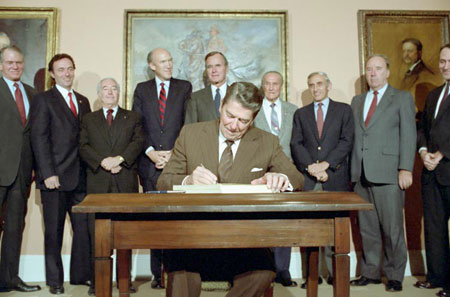
President Ronald Reagan in the Roosevelt Room signing the Immigration Reform and Control Act of 1986. (Reagan Library)
19. Immigration Act of 1990
- Allowed the president to grant "temporary protected status" to immigrants from certain countries that might be afflicted with armed conflict or a natural disaster.
- Removed the ban on lesbian and gay immigrants.

Post-earthquake in Port-au-Prince, Haiti, January 2010. Haitians were granted Temporary Protected Status after the disaster. (Colin Crowley/Flickr)
20. Illegal Immigration Reform and Immigrant Responsibility Act of 1996
- The law instituted a ten-year ban for entering the country illegally and staying for more than a year.
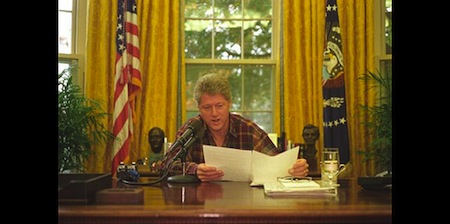
President Bill Clinton delivering the weekly radio address in the Oval Office, Nov. 6, 1993. (U.S. National Archives/Flickr)
21. Creation of Homeland Security (2002)
- In response to the 9/11 terrorist attacks, the U.S. realigned its immigration agencies, placing all agencies under the new department called Homeland Security.
- In the decade following 9/11, spending on border security and deportations increased dramatically.

President George W. Bush pauses during a meeting in the Oval Office, Oct. 10, 2001. (U.S. National Archives/Flickr)
22. Secure Fence Act of 2006
- Congress approved $1.2 billion for 700 miles of fence along the U.S.-Mexico border.

A section of the U.S.-Mexico border fence in Nogales, Mexico. (Ted Hesson/Long Island Wins)
23. Deferred Action for Childhood Arrivals 2012
- President Barack Obama used his executive authority to temporarily halt deportations of young undocumented immigrants who meet certain qualifications, such as attending high school.
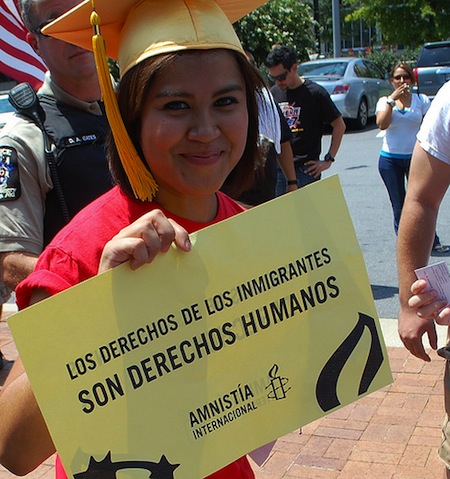
A rally for the Maryland Dream Act. (Edward Kimmel/Flickr)
